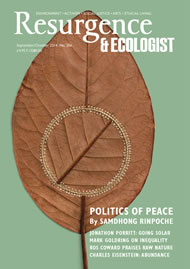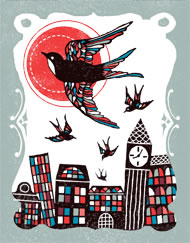I was, and am, a rural girl. I grew up under vast skies and spent summers straying, idling, teetering on the steep banks of rhynes, scanning the water for frogs and spawn. I grew awkwardly tall under those skies. I came of age surrounded by fields where my friends and I would bend to the will of a lazy day, as mellow as shoots of corn in a breeze. There, then, clock hands never called time: it was the hedgerows, expectant with berries, that closed the door on summer holidays. And when winter was near ready to claim the land we knew, those mighty skies paled to white and silence.
I arrived in London in September 2002, at the age of 22. And even by then, fresh out of a university in Warwickshire, itself defined by fields, I’d rarely been surrounded by so many buildings. I had drifted to the city on a whimsical tide and docked without plan or job. Outrageously broke, too. It was about love, as many barely considered leaps of faith so often are. And faithful to a summer crafting what-next stories under the fluttering campus oaks, I’d followed him. Followed him to a landscape fortified with so much tarmac and steel that I could only catch glimpses of the sky as spindly fragments between the tower tops.
London, his natal city, anchored him. But I was rootless, barely breathing as I negotiated my way through the tight weave of my citified environment: ill-fitting temp jobs, a concoction of cocktail bars, old friends in new, responsible suits. We failed, but the city and I did not. And over a dozen years hence, I’m still here, a Londoner.
In the early days, I survived by denying what I thought I was. The career success it promised, I told myself, would make up for the sacrifices being borne by my gypsy soul. But as the years rolled on, something changed: the city began to expose my capacity for hardness, even ambition. Meanwhile I uncovered its own multiple, competing selves, some kind, wild and spirited. And while keeping pace with the hard house London beat exposed my own tough edges, the city, in turn, revealed its softer personalities and moods to me.
A decade on, I now write about Nature in the city. A tense paradox. An awkward pairing of contrasting worlds. These are both things you could assume. Indeed, when I set out to focus my work in this way, sceptical friends asked me if I worried I’d run out of things to write about, “and quickly”. I also met many who assumed that London’s natural, green space – still one third of all its kingdom – is somehow more artificial, less relevant to an understanding of what the wild is, believing it to be undermined or confined by its urban context.
But the complete opposite is true. London has a wild self that speaks. It’s a side of the city that negotiates challenges in a language that’s crucial for all of us to learn, as half the world’s population will soon find itself living in cities. For me, it’s that very tension between the human-made world and the natural world in one physical place that goes to the heart of how we, as human beings, learn to live a life that bridges the two. It’s these stories, that describe this attempt at understanding, that fascinate me as a writer.
It wasn’t until 2010 that I found myself at this equator. After six lost and miserable years as a business journalist, I quit my editing job, mindful of what the magnificent Jay Griffiths describes as the two sides: “the agents of waste and the lovers of the wild. Either for life or against it. And each of us has to choose,” she roared from the pages of Wild.
For me, that was a challenge about truthfulness – not to that rural child but to something present and innate. And that summer, idling on how to follow a different path, my friend Tina Smith and I fashioned a plan to launch our own magazine. At the time London’s boom economy had exhausted itself, creating a need by those who lived there to nurture a more meaningful, self-sufficient relationship with their urban surroundings. Like me, more and more Londoners appeared to be re-examining what it was that made them feel truly real, and were finding the same answers.
All of a sudden, foraging groups, home-grown-food collectives, rooftop beehives and new community orchards were proliferating, luscious green blooms spreading out across the pavements. The movement – or so it appeared to us, anyway – seemed to express something deeper about how many of us wanted, needed, to live in cities, and we urgently wanted to capture and articulate it. So we set to it, creating designs, persuading busy people to be interviewed for our non-existent publication, and coaxing other artists and writers to help us make it happen.
After a few months and many long nights in Tina’s spare bedroom-cum-office in Tooting, we carefully pieced together the first issue of Lost in London – an indie magazine with a mission to show people that even in a heaving metropolis it is possible to live in symbiosis with Nature.
Back then, it was a mission born out of hope rather than conviction. But ask anyone who’s seen the peregrine falcon chase lunch from the roof of the Tate, and they’ll tell you that this odd distinction we draw between the ‘natural’ and the ‘human’ world is ludicrously artificial. And the more I looked, the more I realised it.
I discovered the river Thames, a pulsing natural aqueous landscape, which surges eight feet higher when the moon is at her fullest. I met a painter in Putney who visits its foreshore each day just to capture splinters of light as they strike the water’s surface anew. I walked many miles of the capital’s Green Chain route to the city’s ancient woodlands: delicate, sweet universes lined with the spent leaves of hundreds of years, that sing with the rarest of beings – trees, butterflies, birds. And under dusky skies, I crossed heaths in search of bats, all the kinds you’d find in any other place in Britain.
That symbiosis is not always easy to achieve. At a former dockyard in Rotherhithe I met people who’ve turned a troubled wasteland into rugged woodlands to give urban children a space to roam, as they continually fight those trying to build at its boundaries.
In the borough of Ealing, I explored a nature reserve coated in millions of bluebells (and rare plants and insects besides), where generations have held off creeping suburban sprawl since 1902 – with the latest guardians now fighting maybe its hardest battle yet: the HS2 railway project.
On a wetland in the east, I met conservationists who are painstakingly nurturing seedlings of a once widespread but now extinct London plant – the marsh sow-thistle – against the near-impossible odds created by severe habitat loss.
London’s wild self screams in struggle. But its victories and losses represent something of our ability to make space for Nature in the most pressurised of circumstances. And if we can do this in landscapes where population densities are at their greatest, there is hope.
Will I ever return to live under those mighty skies of my childhood? If that day ever comes I’ll know it was only living life in the city that taught me that the wild is not a distant place, moving ever further from the city’s walls. That the natural world in the urban context is as real as the bricks and the railway tracks. That London is a landscape with ancient contours, marshland, chalk, wood, water, and wild-hearted city-dwellers who tune in to it all. And, as I observe this natural and human world jostling together, I’m reminded of the danger, of the false distinctions between the urban and ‘other’ – if only to ourselves. And for that, dear London, I will forever be grateful.







